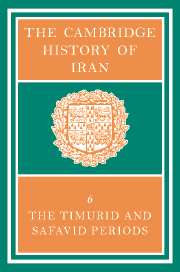Book contents
- Frontmatter
- 1 THE JALAYIRIDS, MUZAFFARIDS AND SARBADĀRS
- 2 TĪMŪR IN IRAN
- 3 THE SUCCESSORS OF TĪMŪR
- 4 THE TÜRKMEN DYNASTIES
- 5 THE SAFAVID PERIOD
- 6 THE SAFAVID ADMINISTRATIVE SYSTEM
- 7 EUROPEAN CONTACTS WITH PERSIA, 1350–1736
- 8 TRADE FROM THE MID-14TH CENTURY TO THE END OF THE SAFAVID PERIOD
- 9 SOCIAL AND INTERNAL ECONOMIC AFFAIRS
- 10 THE EXACT SCIENCES IN TIMURID IRAN
- 11 PERSIAN SCIENCE IN SAFAVID TIMES
- 12 RELIGION IN THE TIMURID AND SAFAVID PERIODS
- 13 SPIRITUAL MOVEMENTS, PHILOSOPHY AND THEOLOGY IN THE SAFAVID PERIOD
- 14 CARPETS AND TEXTILES
- 15 (a) TIMURID ARCHITECTURE
- (b) SAFAVID ARCHITECTURE
- 16 (a) THE PICTORIAL ARTS IN THE TIMURID PERIOD
- (b) THE ARTS IN THE SAFAVID PERIOD
- 17 (a) PERSIAN LITERATURE IN THE TIMURID AND TÜRKMEN PERIODS (782–907/1380–1501)
- (b) HĀFIZ AND HIS CONTEMPORARIES
- (c) PERSIAN LITERATURE IN THE SAFAVID PERIOD
- 18 PERSIAN POETRY IN THE TIMURID AND SAFAVID PERIODS
- Bibliographies
- Plate section
- Plate section
- Plate section
- Maps
- References
9 - SOCIAL AND INTERNAL ECONOMIC AFFAIRS
Published online by Cambridge University Press: 28 March 2008
- Frontmatter
- 1 THE JALAYIRIDS, MUZAFFARIDS AND SARBADĀRS
- 2 TĪMŪR IN IRAN
- 3 THE SUCCESSORS OF TĪMŪR
- 4 THE TÜRKMEN DYNASTIES
- 5 THE SAFAVID PERIOD
- 6 THE SAFAVID ADMINISTRATIVE SYSTEM
- 7 EUROPEAN CONTACTS WITH PERSIA, 1350–1736
- 8 TRADE FROM THE MID-14TH CENTURY TO THE END OF THE SAFAVID PERIOD
- 9 SOCIAL AND INTERNAL ECONOMIC AFFAIRS
- 10 THE EXACT SCIENCES IN TIMURID IRAN
- 11 PERSIAN SCIENCE IN SAFAVID TIMES
- 12 RELIGION IN THE TIMURID AND SAFAVID PERIODS
- 13 SPIRITUAL MOVEMENTS, PHILOSOPHY AND THEOLOGY IN THE SAFAVID PERIOD
- 14 CARPETS AND TEXTILES
- 15 (a) TIMURID ARCHITECTURE
- (b) SAFAVID ARCHITECTURE
- 16 (a) THE PICTORIAL ARTS IN THE TIMURID PERIOD
- (b) THE ARTS IN THE SAFAVID PERIOD
- 17 (a) PERSIAN LITERATURE IN THE TIMURID AND TÜRKMEN PERIODS (782–907/1380–1501)
- (b) HĀFIZ AND HIS CONTEMPORARIES
- (c) PERSIAN LITERATURE IN THE SAFAVID PERIOD
- 18 PERSIAN POETRY IN THE TIMURID AND SAFAVID PERIODS
- Bibliographies
- Plate section
- Plate section
- Plate section
- Maps
- References
Summary
In discussing the economic situation of Iran from the 14th to the 18th century, it seems to us helpful to keep two essential sectors distinct from one another: on the one hand the economy of the open countryside (above all, agriculture, cattle-breeding, hunting, fishing and mining) and on the other hand the urban economy (commerce and industry). Let us turn initially to the sector of rural production, with agriculture and cattle-breeding as its predominant elements. This created to a great extent the basis for almost all the economic activities we shall encounter in the period we are to treat. Subsequently the development of the various forms and institutions of landholding will have to be examined. Thereafter we shall treat the urban sectors of the economy (home trade and industrial production), and we shall end with a description of the financial and taxation systems.
THE RURAL ECONOMY
In the framework of agrarian production we encounter above all two sharply demarcated social groups. While the settled peasants mostly devote themselves to agriculture, cattle-breeding is above all in the hands of nomads and semi-nomads. Let us first discuss some characteristic features of peasant production in our period.
The damage done to Iran's agriculture by the Mongol invasion showed its effects for centuries, and it is questionable whether the country, down to the end of the Safavid period, ever regained the degree of prosperity that distinguished Iranian agriculture from the 4th/10th to the 6th/12th century, though there were indeed regional exceptions. The reasons for this setback lay above all in the destruction of irrigation works, some of them centuries old, and in the deforestation and depopulation of the country: both of the latter were direct consequences of the Mongol invasion.
- Type
- Chapter
- Information
- The Cambridge History of Iran , pp. 491 - 567Publisher: Cambridge University PressPrint publication year: 1986
References
- 7
- Cited by



